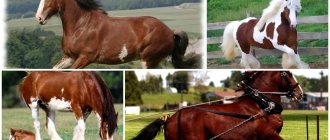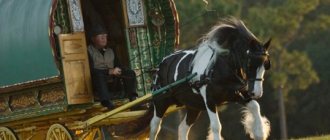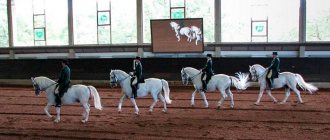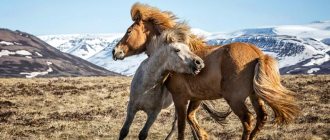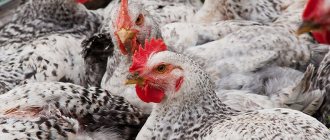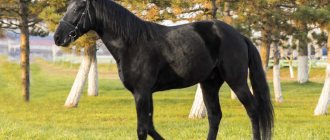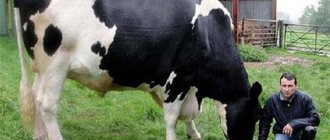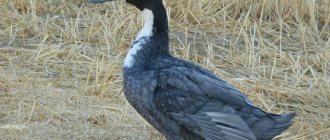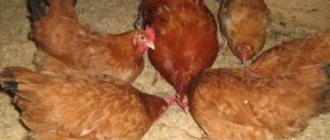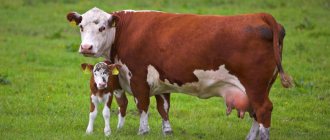How did the breed appear and why does the horse look like this?
The history of the appearance of the breed does not have a definite version. There are several assumptions regarding the origin of the small Falabella horses. Some believe that this breed appeared due to a lack of substances necessary for the growth of animals. Allegedly, once upon a time, ordinary horses fell into a deep canyon and could not get out of it. So, over time, short horses were born, which was later preserved genetically.
There is an opinion that the horse got its name from an Argentine farmer who found him in a canyon and then brought him to the ranch. The man's surname is Farabella, which is why horses began to be called by that name. Although the farmer tried to fatten the horses with feed, this did not produce any results; they remained short in stature.
Another version is slightly different, but it also mentions the Falabella family, to whom, allegedly, the leader of the Kayak Indian tribe passed on the secret of breeding mini-horses. This assumption seems very doubtful if we take into account that in those parts the Indians were warlike and preferred to raise war horses.
The history of miniature horses
In some regions of South America, over time, horses whose ancestors were the Iberians brought by the Spaniards proliferated, among them there were also individuals belonging to the famous Andalusian breed. In the 60s of the 19th century, several small animals born as a result of inbreeding (close crossbreeding) were discovered in a herd of Mapuche (Araucan) Indians.
The Falabella horse breeding program started back in 1868. Its initiator was Patrick Newtall. In his work, he used representatives of the local Criollo population.
Particular attention was paid in breeding to the following parameters:
- general elegance and sophistication of appearance;
- balanced, proportional physique;
- acceptability of the types of different breeds found in the Falabella.
His work was continued by Juan Falabell, who supplemented the experimental herd with Welsh and Shetland ponies and other small horses. Thanks to inbreeding, he achieved his goal; the animals' growth decreased.
The official breed registry was created in 1940 by Julio C. Falabella, a descendant of Juan. He also set out to stabilize the horses' height. The breeders have achieved good results and set the modern standard - 76 cm.
Description and characteristics of the horse
Falabella is a small horse, 50-75 centimeters high. Her weight is only 50-60 kilograms. But there is an animal of this breed in the world, weighing only 13.5 kilograms and 50 centimeters tall.
Horses are characterized by a small, proportional body with long legs, and small limbs on the hooves. The animal has a small head, which corresponds to its small stature. The Falabella has one less rib and one less vertebra than the average horse. A distinctive feature of the breed is its thin skin and pleasant-to-touch coat. There are speckled and piebald individuals.
The peculiarity of the animal is friendliness, calmness and kindness. Falabella is a good-natured animal that finds contact with people. They are valued for their sharp minds, quick learning abilities, and the fact that they are trainable. Animals can jump well, which helps them overcome any obstacles. Farmers often install artificial barriers in their yard for entertainment purposes and training horses.
Today the breed is very popular among connoisseurs of unique types of horses. Its demand is due to its habits. Falabella is bred and kept not on farms, but in a private house or apartment. In addition to the fact that animals are able to jump well, they can run for a long time at high speed - this is also about them. The breed quickly gets used to its breeder, remains devoted to him, tries to please him, showing his capabilities and skills.
Photo gallery
Falabella foal
Falabella in ammunition
Large falabella
Falabella on its hind legs
Falabella with a girl
Falabella is just like a person
Purpose of the breed
Mini horses are mostly decorative and are not intended for riding. Falabella is capable of pulling a cart with one adult or two children. The animal is often kept as a pet. It is so fragile and graceful that it is unlikely that anyone will dare to use it to do household work. In addition, the cost of such a horse is quite high (3-4 thousand dollars), due to which the animal is purchased as an element of luxury and wealth.
Horses also perform in the circus arena; they are easy to train and they like to show off in front of the public. Very often, such animals are owned by people with disabilities, which is due to their good disposition and long life expectancy - Falabella lives up to 45 years.
Reviews
According to farmers, the advantages of the breed include:
- patience - these horses can be used as guide horses;
- ease of care - horses are often bred by inexperienced farmers or breeders;
- high intellectual abilities – due to this, the training process is significantly simplified;
- good life expectancy;
- calm character.
The negative aspects of the breed are due to the peculiarities of its physique.
These include the following:
- fragile skeleton and low draft force - these features do not make it possible to use the falabella for complex physical work;
- congenital intestinal problems - observed in some individuals, which requires a special diet;
- Difficulties with breeding - horses have difficulty with childbirth.
Care
Breeding mini-horses is no different from keeping and caring for large horses, the only difference is the size of the animals. A wooden stall, where one large horse is usually placed, can accommodate 2-3 mini-horses of this breed. Their calm nature and friendliness allow them to get along well not only with each other, but also with other pets.
In relation to a small horse, you must adhere to the same rules as when caring for large horses: regularly brush, bathe, and clean the hooves of foreign bodies and debris. In addition, to examine ornamental pets, it is necessary to call a veterinarian who will systematically examine the horses, vaccinate and deworm them, taking into account their weight in order to avoid overdoses.
A married couple shares their recommendations for caring for a Falabella horse. The video describes the features of the ornamental animal:
Diseases
Falabella horses, like everyone else, can be susceptible to the following diseases:
- cold;
- colic;
- eczema;
- biting midge;
- anthrax;
- rabies;
- smallpox;
- botulism;
- tuberculosis;
- tetanus;
- leptospirosis;
- casual disease;
- laminitis;
- rheumatic inflammation of the hooves;
- ringworm;
- flu;
- azotrorrhea;
- washed;
- scabies;
- rain crust;
- COPD
Treatment and prevention are carried out depending on the disease.
If there are a large number of animals in the stable, it is recommended to carefully monitor their health status. Diseases and parasites spread quickly in close quarters.
To prevent infections, it is worth ensuring high-quality ventilation and adequate heating. This will help to avoid massive damage to horses by respiratory diseases.
Timely vaccination of animals against tetanus, influenza and other common diseases is of no small importance.
Nutrition
The main advantage of keeping mini-horses is the minimal feed consumption. If one large horse needs 3 kilos or more of balanced feed daily, then 300-400 grams of Falabella per day is enough.
Dwarf horses, like other mini-animal breeds, are prone to obesity. For this reason, they need nutrition that is properly formulated for them. In this case, the main thing is not to overfeed your pets.
What recommendations to consider:
- The nutrition of mini-horses is practically no different from the feeding of their large relatives. It is important not to overfeed a miniature animal. If you feed an animal oats in large quantities, it may experience an allergic reaction, manifested by such unpleasant symptoms as itching and eczema on the skin. The horse is fed hay twice a day - in the morning and in the evening.
- Falabella's diet should consist of potatoes, cabbage, and beets. Hay is used as roughage. It is permissible to add concentrates containing vitamins and minerals to it. It is recommended to give the “kids” a few carrots and an apple every day.
- Your pet especially needs fluids. In the summer, it is given water at least three times a day; in the winter, the animals feed on snow. Horses are given water before eating.
The diet for each horse must be selected individually. For a pregnant mare, the volume of food is increased by 5-10% - she needs additional nutrients. The menu itself should be varied.
Conditions of detention
Healthy animals are not too sensitive to cold, but when combined with high humidity - sleet, thick fog, rain, the situation can become catastrophic. At this time they are left in the stall.
The stable area for a dwarf horse does not have to be huge. For one individual, 2x2.5 m is enough. Hay is laid on the floor. The premises are cleaned daily.
Besides:
- there should be no sharp objects in the pasture or in the stable, otherwise the horse will be injured;
- hay nets need to be removed, as it is possible that Falabella will get stuck with its hooves;
- It is better to drink not from buckets, as they are often knocked over, but from special automated drinking bowls.
The pasture should be fenced. A fence made of wooden posts and boards will do. It is possible to install various electric barriers. But chains should not be used; horses may damage their hooves.
Pastures must be regularly cleared of poisonous plants. Falabella horses should not have access to juniper berries, coniferous trees, or yew (taxus) thickets.
Don't forget about the hooves! They must be systematically checked and any pebbles or sharp objects caught in them must be removed. If the hooves are not promptly cleaned of adhering dirt, sand and feces, an inflammatory process may begin. A blacksmith inspection is required once every three months.
Taking care of the fur is an important part of Falabella hygiene. They love to bathe and they love to be brushed. If the horse is cut short, then in winter and spring it should be covered with a blanket on top. At temperatures of -12 ℃ and below, animals are not removed from the stall.
Breeding
The main difference between Falabella and ordinary horses is the foaling period, which lasts not 11 months, but 1.1 years. During the first year of life, the foal manages to grow to the required height and becomes independent. By the age of three, a mini-horse is considered fully developed. Initially, the height of a newborn horse is 40 centimeters.
The first minutes after birth, little Falabella gets to know the new environment, does not recognize the mother mare and begins to look for her by smell. During the dating period, there should be a person near the foal - the animal will begin to consider him a member of its family. He can rush after passing horses just because they attracted his attention - he will follow them. But the vigilant mare is always close to her child, and scares away everyone who approaches him.
To get to know the new resident of the stable, adult horses begin to play with the baby, which promotes rapid adaptation. The mother especially carefully protects her baby for a month, and after 7-10 months she stops feeding him milk and pushes him away with her hooves, driving him away from her udder.
Today, mini horses are bred as ornamental pets. They are provided with favorable conditions, protected from diseases and attacks by other animals, and everything is done to make the Falabella feel comfortable.
How much does a falabella cost?
As with other horse breeds, the price of a Falabella can vary significantly. It all depends on factors such as:
- documents, vaccination certificate;
- pedigree;
- age of the animal;
- health status and external data;
- the ability to bear fruit and much more.
An animal that will be purchased for subsequent horse breeding will be expensive. An adult will cost the buyer 250 thousand rubles and more. A small foal can be purchased for 50 thousand rubles, which is five times cheaper than an adult animal. The cost of a full-fledged Falabella mare will also be more than 250 thousand rubles, due to her subsequent offspring.
Interesting Facts
There are several interesting facts about Falabella horses. Below are some of them:
- A unique fact is that the Falabella has 1 vertebra and 1 less rib than other representatives of various breeds.
- Although Falabella is no more than 75 cm tall, the animal is very active, brave, capable of jumping high and running long distances for a long time, developing excellent speed.
- Many aesthetes prefer to have such horses as pets. In addition, the advantage of the animal is the absence of unpleasant odors - horses are taught to relieve themselves in a designated place.
- Falabella are prone to changes in their body temperature. At night, they need to live in a warm room, protected from cold and drafts, but with good ventilation and heating. The winter season is considered a real test for the breed.
- In the United States of America, many breeds of horses are used for social work. Falabella is an animal used to help blind citizens. With proper training, such a miniature horse can be turned into a good guide, distinguishing sounds, assimilating any commands, and even understanding road signs.
Falabella horses are extraordinary animals that attract people with their miniature size and docile nature. Falabella has extremely positive features and an interesting origin story. Today it is profitable to breed such beauties.
0
0
Copy link
Falabella today
Today, the number of Falabella horses is no more than several hundred. But the main thing is that its numbers are not falling and have positive dynamics. Horses have increasingly become domesticated by people, so much so that they live with them in the same premises and share the house with humans on equal terms. In the United States, the practice of helping socially disadvantaged segments of the population with mini-horses, which have become faithful guides for the disabled, is widely used.
Falabella is used to teach horse riding to young children, with whom the horses get along well. You can get along well with a horse in the same house, since it does not emit unpleasant odors, can be trained quickly and easily, and goes to relieve itself in its designated place. In addition, such a pet will live next to its owner for about 35-40 years, which makes friendship with him even more attractive and promising.
Exterior
Isabella horse color is very rare. Such animals have a yellowish-cream color of the body, head and limbs. The skin of such noble horses is pale pink, the eyes have a beautiful blue or green tint. Experts consider the presence of magpie eyes in animals of this breed to be quite rare. In terms of its type, the Isabella horse is similar to the light nightingale horse, since its mane and tail have the same color as the body.
In America they use the term "cremello", which is the name of a red horse. We can safely say that cream color is the clearest example of incomplete albinism. As a rule, foals are born white, with delicate pink skin and beautiful blue eyes. And, if the eyes of growing horses do not change their color, then their fur gradually becomes a certain color.
A rather rare occurrence in Isabella horses is the presence of dark or light brown eyes. Only by the color of the descendants of horses of a given breed can one accurately determine whether this representative of the noble English breed was gray, red or black. The isabella gene in a certain homozytic state is clarified with a special black pigment. It is not often that a pair of identical genes meets, which are sufficient to form such a suit. In turn, the appearance of such genes led to the formation of other colors: based on a cream shade - Solovaya, Akhal-Teke, Palomino.
Filmography
Movies
| Year | Russian name | original name | Role | A comment |
| Francoise | Françoise | Francoise | Short film | |
| Two lost in the dark of the night | 2 Perdidos numa Noite Suja | Paco (Rita) | ||
| Lisbela and the Criminalrupt | Lisbela eo Prisioneiro | Lisbela | ||
| Looney Tunes: Back in Business | Looney Tunes: Back in Action | Kate Houghton | Voice acting | |
| Kazuza - time cannot be stoppedrupt | Cazuza - O Tempo Não Pára | Denise Dumont | ||
| Mistress of fate | A dona da history | Caroline (young) | ||
| Forgotten Boys: 5 Mentiras | Soloist | Music clip | ||
| Sidney Magal: Tenho | Girl in a yellow dress | Music clip | ||
| Cousin Basiliorupt | Primo Basilio | Louise | ||
| La Dolorosa | Miranda | Short film | ||
| Number 38 | Quarto 38 | Simone | Short film | |
| Sweet and Bitter | Doce Amargo | Moira/Moema | Short film | |
| My countryrupt | Meu Pais | Manuela | ||
| Good peoplerupt | Homes de Bem | Mary | ||
| Three monkeys | Dois Macacos Mais Um | Didn't come out | ||
| Eternal sonrupt | About Filho Eterno | Claudia | ||
| Kiss on the asphaltrupt | O Beijo no Asfalto | Selminha | ||
| All the clichés of love | Todo o Clichê de Amor | Ellen | ||
| Depois a louca sou eu | ||||
| Dedicated to Francis | Para Francisco | Chris Guerra |
TV serials
| Year | Russian name | original name | Role | A comment |
| Workout/Lace/New Herculesrupt | Malhação | Antonia | ||
| In the world of women | Mulher | Ana (Aninya) | Series “The Incident” (“O Acidente”) | |
| Kids | Chiquititas | Estrella | ||
| Angel who fell from heaven | Um Anjo Caiu do Ceu | Maria Cristina de Montaltino Medeiros (Cuca) | ||
| Clone | O Clone | Melissa Ferraz (Mel) | ||
| Now it's their turn | Agora É que São Elas | Leonarda Mendez Galvao (Leo) | ||
| Casseta & Planeta, Urgente! | Special participation | |||
| Just one heartbreak | Um So Coração | Raquel Rosenberg | ||
| Mistress of fate | Senhora do Destino | Maria Eduarda Correa de Andrade y Cota (Duda) | ||
| Juscelina Kubitschek | JK | Sarah Lemos Kubizek (young) | ||
| Senorita | Sinha Moça | Maria das Grasas Ferreira (Señorita) | ||
| Sitcom.br | Episode “Dot the i's” (“Ponto nos Is”) | |||
| Cineview | Presenter | |||
| Two faces | Duas Caras | Julia de Queiroz Barreto | ||
| The Sound and the Furyrupt | Som & Furia | Sarah | ||
| It's destined in the stars | Escrito nas Estrelas | Beatriz Cristina Tavares de Miranda | ||
| Hype | Ti Ti Ti | Isabel Campos Dimeri | Participation in the last 30 episodes | |
| Invisible woman | A Mulher Invisive | Clarisse | Seasons 1 and 2 | |
| Good peoplerupt | Homes de Bem | Mary | TV movie | |
| Brazil Avenue | Avenida Brasil | Nina Garcia Hernandez (Rita Fonseca de Souza) | ||
| Dual Identity/Multiple Personalityrupt | Dupla Identidade | Ryan Gurgel (Rey) | ||
| Vilerupt | As Canalhas | Julieta | Season 3, Episode “Julieta” | |
| Nothing will be the same again | Nada Será Como Antes | Veronica Maya | ||
| The Power of Desirerupt | A Força do Querer | Irene Steiner/Solange Lima | ||
| If I close my eyes now | Se Eu Fechar os Olhos Agora | Isabel Marquez Torres | ||
| Aravans | Aruanas | Natalie |
In the theatre
| Year | Russian name of the play | original name | Role | Director | A comment |
| Flicts | Ziraldo Alves Pinto | ||||
| The Addams Family | The Adams | Wednesday Addams | Carlos Gradim | ||
| White Nights | Noites Brancas | Nastenka | Yara de Novaes | ||
| Snake | A Serpente | Guide | Yara de Novaes | ||
| Black Continent | About Continente Negro | Three characters | Aderbal Freire Filho | ||
| Love and other strange rumors | O Amor e Outros Estranhos Rumores | Three characters | Yara de Novaes | ||
| 2013-2018 | Contractions | Contrações | Emma | Grace Passô | |
| The King and the Enchanted Crown | O Rei ea Coroa Enfeitiçada | Deborah Falabella and Cynthia Falabella | |||
| View of Alaska | Uma Espécie de Alaska | Gabriel Fontes Paiva | Costume Designer: Deborah Falabella | ||
| 2015-2016 | Keep away from children | Mantenha fora do alcance do bebê | A girl who wants to adopt a child | Eric Lenate | |
| 2017-2018 | Love love love | Love, Love, Love | Sandra (young), Rose | Eric Lenate |
How much does an adult horse weigh on average?
